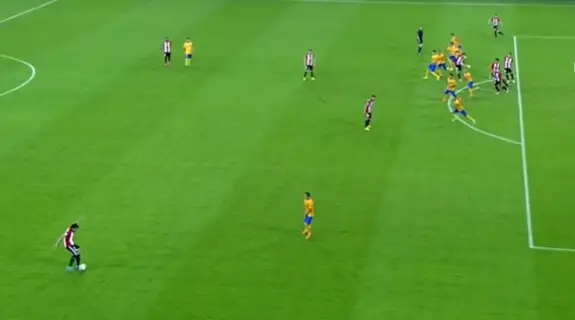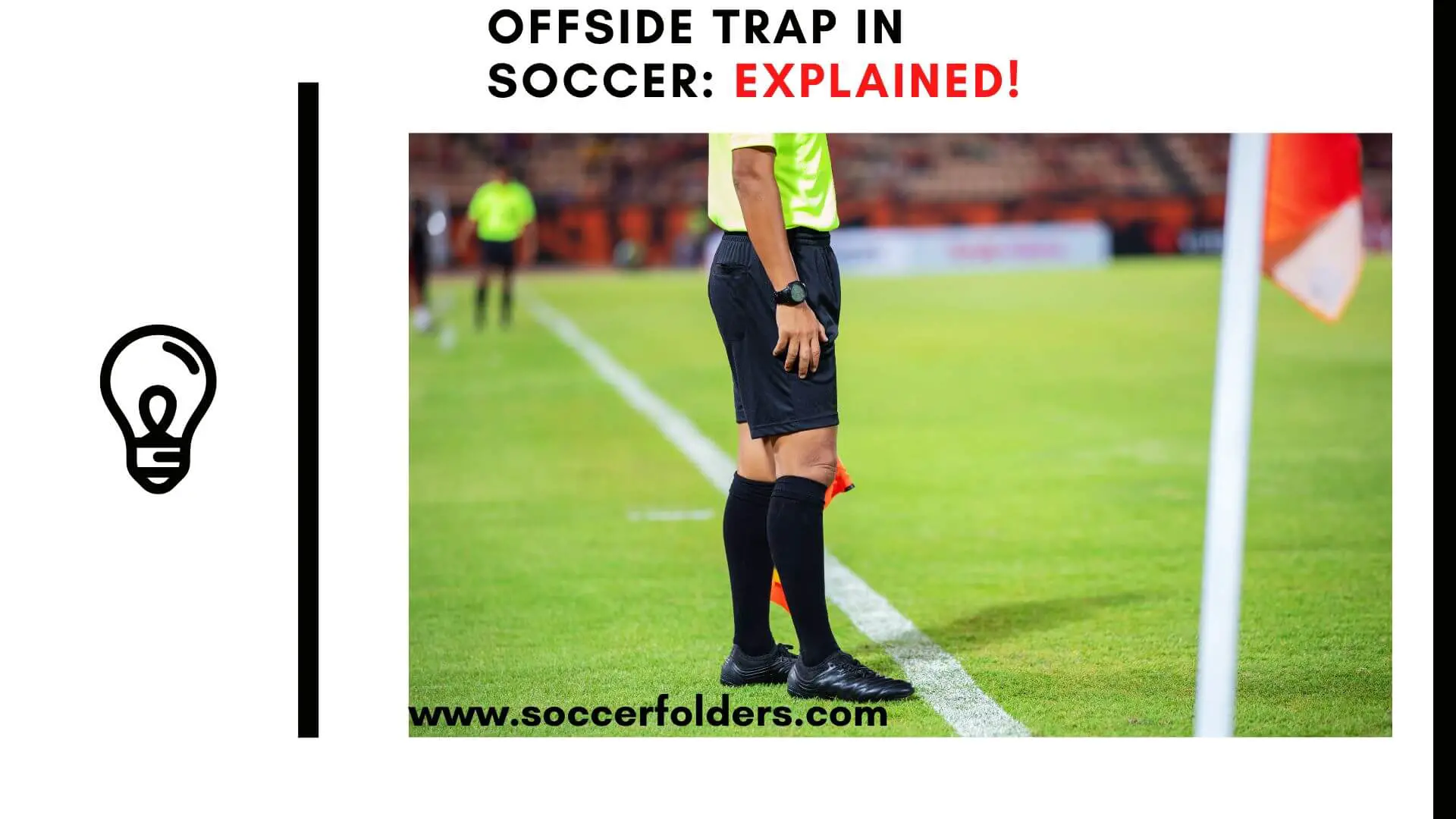Soccer is a game of skill, tactics, and strategy. One of the most effective defensive strategies used by teams is the offside trap.
This technique can be used to great effect against opposing teams and can help your team win more games.
In this guide, we will explore what the offside trap is, and everything there is to know about it.
Let’s get started.
- What Is The Offside Trap?
- Types Of Offside Traps
- Benefits Of Using An Offside Trap
- When To Use An Offside Trap?
- How To Execute An Offside Trap In Soccer?
- Tips For Executing An Offside Trap
- Common Mistakes To Avoid When Using An Offside Trap
- Strategies For Defending Against An Offside Trap
- Offside Trap Drills
- Final Word
What Is The Offside Trap?
The offside trap is a defensive strategy used in soccer where the defending team positions their players in such a way that an attacking player is in an offside position when they receive the ball. This means that the attacking player is in a position where they are nearer to the goal line than the ball and the last two defenders, making them ineligible to receive the pass.
This is a great way to disrupt the attacking team’s momentum, as they will be unable to complete the pass and will have to retreat and start their attack from further up the field.
The offside trap is a great strategy to use against teams who rely heavily on the long ball or teams who have quick attackers who can make swift runs into the box.
It is a great way to prevent the opposition from getting chances on goal, as they will be unable to make the pass forward.
Types Of Offside Traps
Several different types of offside traps can be used in soccer.
The most common type is the flat offside trap, where the entire defensive line is positioned in such a way that any pass made by the attacking team will result in an offside.
This is a great way to stop an attack before it even starts.
Another type of offside trap is the zonal offside trap. This is when the defending team positions their players in a zonal formation and any pass made into the zone will be offside.

As you can see from the image above, the defenders in white-red are perfectly playing the offside, leaving the opposing forward in an offside position.
This type of offside trap can be effective against teams who are comfortable playing the ball through tight spaces, as it will be difficult for them to complete the pass.
The last type of offside trap is the dynamic offside trap. This trap occurs when the defending team moves as a unit to create an offside line whenever an attack is made.

See in the image above how the entire back line moves forward altogether to leave the opposition offside.
This type of offside trap is great for teams who are comfortable playing the ball quickly and accurately.
Benefits Of Using An Offside Trap
There are several benefits to using an offside trap in soccer.
Firstly, it can disrupt the momentum of the attacking team, as they will be unable to complete the pass. This can give the defending team time to regroup and set up a better defensive line.
Secondly, it can help the defending team prevent goals. By disrupting the attacking team’s momentum, they will be unable to create chances on goal.
So, this can help the defending team keep a clean sheet and prevent the opposition from scoring.
Thirdly, it can create turnovers. As the attacking team will be unable to complete the pass, the defending team will be able to gain possession of the ball and start their own attack.
This can be a great way to create scoring opportunities for the defending team.
Finally, it can be used to tire out the opposition. As the game goes on, the attacking team will become fatigued from having to restart their attacks from deeper positions, potentially reducing their effectiveness.
When To Use An Offside Trap?
The offside trap is most effective against teams who rely heavily on the long ball or teams with quick attackers who can make swift runs into the box.
It is also effective when used against teams who are comfortable passing the ball through tight spaces or teams who are comfortable playing the ball quickly and accurately.
The offside trap should not be used against teams who rely heavily on passing the ball around the field(For example, Barcelona or the Spain national team), as the defending team will be unable to set up the offside trap in time.
It should also not be used against teams who have slow attackers, as they will be unable to make runs into the box quickly enough to be in an offside position.
How To Execute An Offside Trap In Soccer?
Executing an offside trap in soccer is relatively easy once you know the basics.
The first step is to set up the defensive line. The defensive line should be set up in such a way that any pass made by the attacking team will result in an offside.
This can be done by having the defenders spread out across the field and making sure that the last two defenders are positioned in such a way that any pass made will be offside.
The next step is to make sure that the defensive line is ready to move as a unit to create the offside line. The defenders should be ready to move in sync with each other and be able to quickly adjust their positioning to create the offside line.
The last step is to make sure that the goalkeeper is in position and ready to make a save. The goalkeeper should be prepared to make a save if the attacking team manages to complete the pass and the offside trap does not work.
==>>You can also read Offside rules in soccer.
Tips For Executing An Offside Trap
Executing an offside trap can be tricky and there are a few tips that can help.
The defenders should be aware of any runs that the attackers are making and be ready to adjust their positioning accordingly.
This will help prevent attackers from sneaking into an offside position and receiving the ball.
So, always have an eye open around you and your defender teammates.
Finally, make sure to communicate with other defenders from your team. This will make sure you are all on the same page and know what your next moves will be.
Common Mistakes To Avoid When Using An Offside Trap
When using a soccer offside trap, there are a few common mistakes to avoid.
Firstly, the defensive line should not be too close together. If the defenders are too close together, there will be no offside line and the attacking team will be able to complete the pass.
Secondly, the defensive line should not be too far apart. If the defenders are too far apart, then the attackers will have too much time and space to complete the pass and the offside trap will not be effective.
Thirdly, the defenders should not be too slow to move. If the defenders are too slow to move, then the attacking team will be able to complete the pass before the offside line is set up.
Finally, the goalkeeper should not be too far away from the defensive line. If the goalkeeper is too far away, then they will not be able to make a save if the attacking team manages to complete the pass.
Strategies For Defending Against An Offside Trap
If you find yourself up against an offside trap, there are a few strategies that you can use to beat it.
Firstly, you should try to play the ball quickly and accurately. As the offside trap relies on the attacking team taking too long to make the pass, playing the ball quickly will help to prevent the offside trap from being set up.
Secondly, you should try to play the ball through tight spaces. Playing the ball through tight spaces will help to prevent the offside trap from being set up.
Finally, you should try to play the ball over the top. This will confuse the defending team.
Offside Trap Drills
There are a few drills that can be used to help you and your team master the offside trap.
1. The Flat Offside Trap Drill
This drill involves setting up the defensive line in such a way that any pass made by the attacking team will result in an offside.
The defending team should practice moving as a unit to create the offside line and make sure that the last two defenders are in the correct position to prevent the pass from being completed.
2. The Zonal Offside Trap Drill
This drill involves setting up the defensive line in a zonal formation and having the defenders practice creating the offside line whenever the attacking team makes a pass into the zone.
3. Dynamic Offside Trap Drill
This drill involves the defending team practising moving as a unit to create the offside line whenever an attack is made.
This drill is great for teams who are comfortable playing the ball quickly and accurately, as it will help them to master the offside trap.
Final Word
The offside trap in soccer is a great defensive strategy that can be used to great effect against opposing teams.
This article has explored what the offside trap is, the types of offside traps, the benefits of using an offside trap, when to use it, how to execute it, tips for executing an offside trap, common mistakes to avoid when using an offside trap, strategies for defending against an offside trap, and offside trap drills.
By mastering the offside trap, you and your team will be able to disrupt the opposition’s attack and prevent them from creating chances on goal.
This will help your team win more games and improve your defensive play.
So what are you waiting for? Get out there and start mastering the offside trap!

